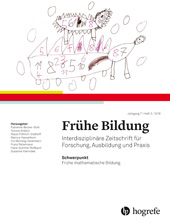Verständnis des geometrischen Begriffs Viereck bei Kindern zwischen vier und sechs Jahren
Abstract
Zusammenfassung. Im Bereich früher mathematischer Bildung gibt es zahlreiche Erkenntnisse zur Entwicklung arithmetischer Kompetenzen. Eher weniger detailliert erforscht ist die Entwicklung geometrischer Kompetenzen. In einer Studie mit 120 Kindern zwischen vier und sechs Jahren wurde deshalb umfassend das Verständnis der Begriffe Viereck und Dreieck untersucht. Dieser Beitrag berichtet Ergebnisse einer Teilstudie, bei der Kinder aus 13 Figuren Vierecke identifizieren sollten. Es zeigt sich kein Zusammenhang zwischen Alter und Identifikationsentscheidungen. Prototypische Vierecke, wie z.B. ein Quadrat, werden signifikant besser als Viereck identifiziert als nicht prototypische, wie z.B. eine Raute. Zudem beeinflussen Seitenverhältnisse, Winkel oder die Lage einer Figur Identifikationsentscheidungen der Kinder, obwohl es sich dabei um für den Begriff Viereck irrelevante Eigenschaften handelt.
Abstract. Numerous results are available in early mathematics education concerning arithmetical competence, but less detailed research is carried out regarding the development of geometrical competence. A study conducted with 120 children (aged between 4 and 6 years) that investigates the understanding of the concept of triangle and quadrangle contributed toward filling this gap. This article reports the findings of a substudy in which the children were asked to identify quadrangles out of 13 shapes. There was no significant relationship between age and shape identification. Children were significantly better in identifying prototypical quadrangles, for example, a square, than atypical ones, for example, a rhombus. Additionally, mathematically irrelevant attributes such as aspect ratio, angle, or orientation of the shape influenced the identifications.
Literatur
(2007). Three- to six-year-old children's recognition of geometric shapes. International Journal of Early Years Education, 15, 83–104.
Bayerisches Staatsministerium für Arbeit und Sozialordnung, Familie und Frauen (2016). Der Bayerische Bildungs- und Erziehungsplan für Kinder in Tageseinrichtungen bis zur Einschulung (7. Aufl.). Berlin: Cornelsen.(1986). Characterizing the van Hiele levels of development in geometry. Journal for Research in Mathematics Education, 17, 31–48.
(2004). A shape is not defined by its shape: Developing young children's geometric understanding. Journal for Australian Research in Early Childhood Education, 11, 110–126.
(2004).
Geometric and spatial thinking in early childhood education . In D., H. ClementsJ., Sarama (Eds.), Engaging young children in mathematics. Standards for early childhood mathematics education (pp.267–297). Mahwah, NJ: Lawrence Erlbaum Associates.(1999). Young children's concepts of shape. Journal for Research in Mathematics Education, 30, 192–212.
(2012). Lernpsychologie.Weinheim: Beltz.
(2016). Didaktik der Geometrie. In der Grundschule (3. Aufl.). Berlin, Heidelberg: Springer Spektrum.
(1988). The van Hiele model of thinking in geometry among adolescents. Journal for Research in Mathematics Education (Monograph Vol. 3), 1–196.
(2006). Exploring young children's geometrical strategies. Nordic Studies in Mathematics Education, 11, 23–50.
(1986). Structure and insight. A theory of mathematics education.Orlando: Academic Press.
(1997). Schulanfänger lösen geometrische Aufgaben. Grundschulunterricht, 44, 36–39.
(2010). The importance of number sense to mathematics achievement in first and third grades. Learning and Individual Differences, 20, 82–88.
(1978). Wörterbuch der Logik. Leipzig: Bibliographisches Institut.
(2007).
Sprache und sprachliche Anforderungen im Mathematikunterricht der Grundschule . In H. SchölerA. Welling (Hrsg.), Sonderpädagogik der Sprache (S.1022–1034). Göttingen: Hogrefe.(2014).
Children's constructions in the domain of geometric competencies (in two different instructional settings) . In U. KortenkampB. BrandtC. BenzG. KrummheuerS. LadelR. Vogel (Eds.), Early mathematics learning. Selected papers of the POEM 2012 Conference (pp.173–187). New York, NY: Springer.(2017). Sprache im Fach Mathematik. Berlin: Springer Spektrum.
National Council of Teachers of Mathematics (NCTM) . (2000). Principles and standards for school mathematics. Reston, VA: Author.(2012). Domain-specific and domain-general precursors of mathematical achievement: A longitudinal study from kindergarten to first grade. The British Journal of Educational Psychology, 82, 42–63.
(2005). Vorkenntnisse von Schulanfängern zu geometrischen Begriffen. Grundschulunterricht, 11, 37–42.
(1975). Cognitive representations of semantic categories. Journal of Experimental Psychology: General, 104, 192–233.
(1998). When is a triangle not a triangle? Young children's developing concepts of geometric shape. Cognitive Development, 13, 547–559.
(1985). Spadework prior to deduction in geometry. The Mathematics Teacher, 78, 419–428.
(2013). Sprachentwicklung beim Kind. Ein Lehrbuch (5. aktual. Aufl.). Weinheim: Beltz.
(2008). Intuitive nonexamples: the case of triangles. Educational Studies in Mathematics, 69, 81–95.
(1984). Methodik des Begriffslehrens im Mathematikunterricht. Stuttgart: Klett.
(2014).
Begriffslernen und Begriffslehren . In H.-G. WeigandA. FillerR. HölzlS. KuntzeM. LudwigJ. Roth (Hrsg.), Didaktik der Geometrie für die Sekundarstufe I. (2. Aufl., S.99–122). Berlin: Springer Spektrum.



